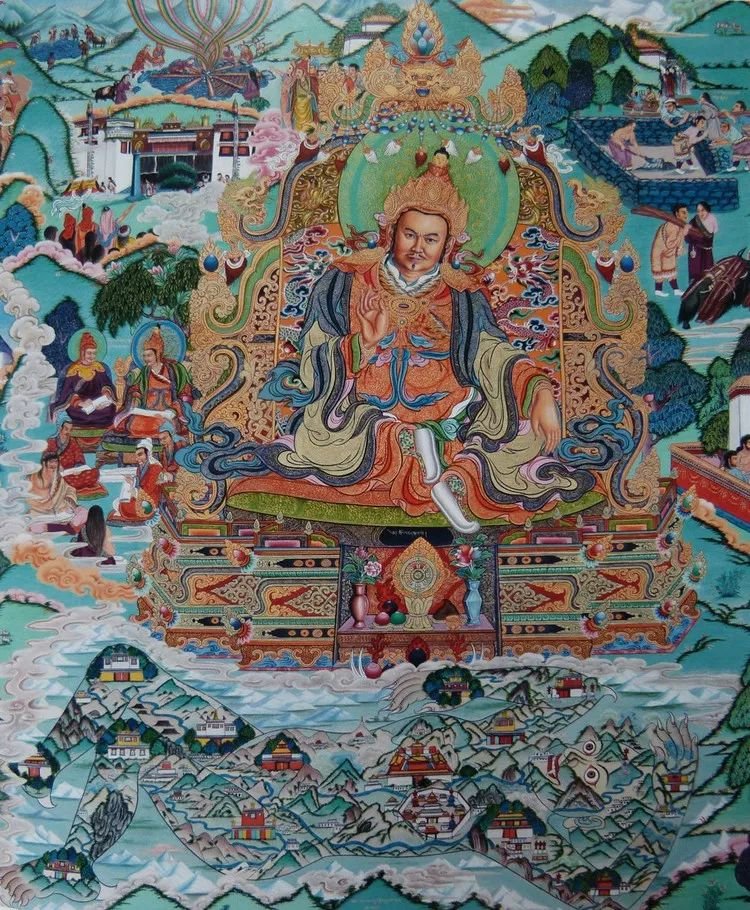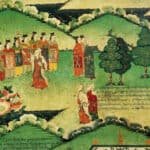At the young age of thirteen, Songtsen Gampo took the throne and sent a minister to Nepal to arrange a marriage alliance with Princess Bhrikuti Devi. The princess brought a statue of the Buddha figure Akshobhya with her when she came to Tibet for the marriage.

Creation of the Tibetan scripts
It is uncertain when Tonmi Sambhota, Songtsen Gampo’s minister, went to Kashmir to learn Sanskrit. He studied under Lipikara and Devavidyasimha and developed a Tibetan script based on the Indian Brahmi and Gupta scripts. He then translated The Tough Mystery texts into Tibetan.
According to A. F. Rudolf Hoernle, the Tibetan script was primarily developed from the Khotanese adaptation of the Indian Upright Gupta script. This is evident in the similar manners employed by the Tibetan and Khotanese scripts to indicate initial and long vowels and place vowels in the order of their alphabets, which differ significantly from other Indian-derived scripts.
Khotan was a Buddhist kingdom on the Silk Route near western Tibet, and Tonmi Sambhota may have studied with a Khotanese tutor in Kashmir because of the trade route from Khotan to Tibet via Kashmir.
Marriage alliance with Tang Dynasty
Songtsen Gampo aimed to expand his empire beyond Central Tibet, particularly to the north and east. After a long period of wars, he conquered the Chang, Bailan (sBa’i-lang), and Dangxian (Thang-shang) tribes and sought an alliance with China through marriage to Princess Wencheng, daughter of the Tang Emperor Taizong (r. 627 – 650). However, the Tuyuhun Kingdom’s ruler, Thokiki, also sought marriage with Princess Wencheng. The Tuyuhun had ruled the Kokonor region of northern Amdo since the fourth century.
When the Chinese Emperor Taizong initially refused to grant Princess Wencheng’s hand in marriage, Songtsen Gampo attacked the Chinese frontier province of Songzhou. Finally, in 641, he received the Chinese princess as his bride and another Buddha statue were brought to Tibet.
Construction of Two Buddhist Temple, Jokahng and Ramoche and Potala Palace
The Tibetan ruler erected two Buddhist temples in the metropolis of Kyishoe, which later became known as Lhasa. He constructed the Potala Palace atop the crimson hill. To accommodate the two Buddha sculptures brought by his wives from Nepal and China. The Ramoche Tsuglagkang was built for the Chinese statue, while the Rasa Trulnang Tsuglagkang subsequently known as the Jokang, was built for the Nepalese statue. Due to security concerns, the positions of the two sculptures were switched in the following generation.
Unification and Expansion of Empire
During this era, Songtsen Gampo expanded the Tibetan Empire to northern Burma and, in 640, to Nepal as well. This marked the inception of Tibetan family clans in Nepal such as Tsang, Lama, Sherpa, and Tamang. In 643, the Tibetan Empire grew further as Legmi, more commonly known in Tibetan language as Li Migkya, the final ruler of Zhang-zhung, surrendered, and Zhang-zhung became a subordinate state.
Referring to traditional Tibetan sources, Namkhai Norbu’s Necklace of Gzi states that Songtsen Gampo’s first interactions with Zhang-zhung were amicable. In reality, the Tibetan ruler’s initial wife was King Li Migkya’s daughter Li Tigmen (Li Thig-dman), for whom he offered his sister as a wife to the Zhang-zhung king. The Zhang-zhung princess carried with her many aspects of Bon culture to the Yarlung court. However, in 643, Songtsen Gampo invaded and conquered Zhang-zhung, having King Li Migkya executed.
Using the friendly ties between Tibet and China, Songtsen Gampo requested the Tang Emperor in 645 and subsequently erected a temple on Wutaishan (Ri-bo rtse-lnga), the five-peaked sacred mountain of the Buddha-figure Manjushri in present-day Shanxi Province.
In 648, the Chinese Emperor Taizong dispatched a goodwill delegation to the Indian Emperor Harsha (r. 606 – 647). However, by the time the delegation arrived, Harsha had already passed away, and his minister Arjuna had taken over. Arjuna was intolerant of Buddhism and thus ordered the execution of most of the Chinese delegation. The survivors fled to Nepal and sought Tibetan aid.


















